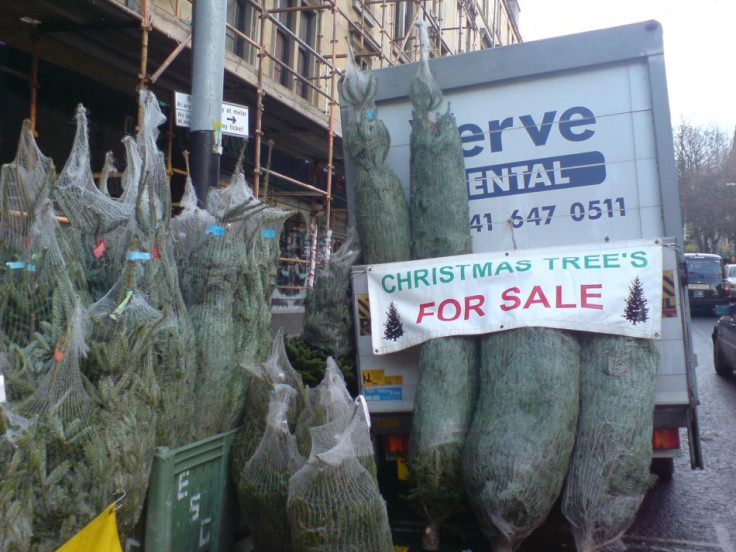Christmas Tree Buying Guide: How to Pick and Care for Your Ideal Tree

People are increasingly buying real Christmas trees in favour of recycling the fake ones that sit in the attic year after year.
While there is still some debate over the ethics of getting a real tree, Rick Dungey, the public relations manager for the National Tree Growers Association, told weather.com that there is no question a real tree is better for the environment.
"You should always choose a plant over non-biodegradable plastic. A plant is a renewable resource, 100% biodegradable and easily recycled. The plastic tree-shape decorations, those are made of non-recyclable, non-degradable plastics and metals. They never decompose. Every one we buy is going to end up in the landfill."
IBTimes UK has put up a Christmas tree buying guide for people getting ready decorate their homes for the festive season.
When to buy?
To ensure the tree looks fresh and healthy throughout the Christmas season, people should buy them after the first week of December. This is to ensure the tree will last between four and six weeks - through to the Twelfth Night on 5 December, when people traditionally take down their decorations.
How big?
This is a pivotal question when it comes to buying a Christmas tree. While you want to avoid a tree too big - National Lampoon-style - you also don't want it to be so small it looks sad in the corner of the room, overwhelmed by the three presents placed below.
To avoid these scenarios, it is important to measure the space it will be filling. You should pick a tree that is one foot shorter than your ceiling height. You should also make sure there is enough space width-wise. Trees are cut to an 80% taper, so a 10ft tall tree will be 8ft wide. Make sure you take a tape measure when going to pick a tree.
Where to buy?

There is no shortage of places to buy a Christmas tree in the UK, with most gardening stores selling them. Sellers also normally set up shop in car parks dotted around the country.
However, larger stores including Homebase, Ikea and Tesco all sell ranges of trees.
While not really ideal for this Christmas or next, an organic option would be to grow your own Christmas tree in your back garden. Growing kits are available to buy online and will make for a sustainable and eco-friendly tree in seven to 10 years. Seedlings should be planted in the spring.
Which type of tree?
There are a number of different types of tree that are used as Christmas trees.
Balsam firs: these have a dark green colour and have flexible branches so are not really suitable for very heavy ornaments. It keeps its shape well and does not drop many needles.
Douglas firs: it will last a long time and have a rounded pyramid shape. They are difficult to come by in the UK as are native to North America.
Scotch pine: these trees have sharp needles so can be difficult to decorate. However, they do not drop their needles and do not dry out, so are very easy to look after.
Norway Spruce: a common type found in the UK, the Norway Spruce tree has a strong colour and can hold heavy ornaments. However, they are not good at retaining their needles.
Blue Spruce: a good pyramid shape with strong limbs, so can support heavy ornaments. It has bluish pines so can appear silvery, which must be considered when thinking about a colour scheme.
What to look out for

Christmas trees that have already been cut are essentially the same as a bunch of flowers - they are dead and are slowly withering away. The longer a tree has been cut, the faster it will become brown and sparse.
People are advised to shake the tree they are thinking about buying to see how many needles fall off - generally, the more needles, the older it is.
If you bend the tree's outer branches and they snap or feel brittle, it has dried out so will be very hard to revive.
Looking at the base, make sure it will fit in your Christmas Tree stand. It should be a maximum of nine inches wide.
Also beware of bugs and insects living in the tree as these can easily be introduced to the home. There have been cases of bats, mice and birds living in trees. On a smaller scale, some people have bought trees that have spider eggs laid on branches, which then begin to hatch over the Christmas period, making for an unhappy surprise.
Caring for your tree

You should check your tree has enough water every day and top up as and when necessary. To reduce dryness, it is advisable to use lights that do not emit a lot of heat, as this can speed up the aging process. Placing a tree near a fireplace or radiator will have the same effect.
It is extremely important to keep the tree hydrated as a dried out tree is a fire hazard that will go up in flames quickly. For this reason, it is paramount all lights are switched off on the tree when you leave the house.
Disposing of the tree

It is estimated that just 10% of trees are recycled, with millions of trees thrown away every year.
Trees are biodegradable so should be recycled. Most councils run services where residents can bring their trees for recycling and some even offer a collection service. People are advised to contact their local authority for information on this. Many garden centres will also take old trees away for recycling.
© Copyright IBTimes 2025. All rights reserved.






















